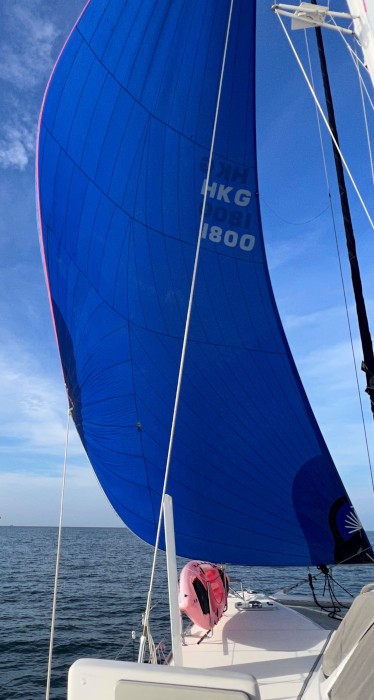We are sailing?
14 August 2022
• Belitung to Batam
by Allyson • Mixed

In the early stages of the rally, the yachties were asked to sing a song at one of the welcoming events. We settled on "I am Sailing" by Rod Stewart. It had simple lyrics that we could all google on our phones and a simple repetitive melody. And yet ... both the lyrics and the melody got thoroughly mangled as we belted out our discordant karaoke-style version of the song. Sadly, this performance had to be repeated time and again at ports throughout western Sumatra. We always received a cheer from our hosts at the end. I am sure it was relief that we had finally stopped.
Despite the basic premise of the song and of our "sailing" rally, the fact of the matter was no one was doing much sailing.
Apart from the stormy passage from the Mentawais to the Sunda Straits, we had motored or motor-sailed about two thirds of our passages. When we did sail, the winds were generally light. By the time we reached Belitung, we decided we were overdue for setting up our huge asymmetrical spinnaker (asym for short) on the bowsprit with its new furling system. The large lightweight sail is designed for the very light winds that seemed to be the norm in this part of the world, but the size of the sail makes it unwieldy to handle, particularly when you are trying to take it down. This is usually done by squeezing it into a fabric tube, called a sock, that you pull down from the top of the sail, ending up with a long sausage-like package when it is pulled all the way to the deck. A lot can go wrong in that process. The alternative is to install a roller-furling system that allows you to attach the sail to a bolt rope, which is rotated by a drum and slowly winds up the sail. We had all of the bits and pieces to build the furling system and after three days of careful measuring, careful cutting, attaching swivels, furling ropes, furling straps, turning blocks and finally the sail, we were ready to give it a try.
Our next passage was a four-leg voyage from Belitung northwest to Batam and the Nongsa Point Marina, and the forecast looked like we might have winds behind us so that we could launch the asym.
But the first leg was due west, straight into the winds, so the sail stayed in the locker and we motored 35 miles to Gelassa, a small island with a small anchorage which we shared with two dozen fishing boats. They all vanished at sunset when they went out to sea in search of squid, shrimp and any type of fish they could lure into their nets with their high-beam spotlights. The looked like fireflies surrounding the island.
In the morning, the winds were light and steady from the south, giving us the ideal sailing conditions for our overnight passage to Pulau Kenar, the next leg of the trip. All went according to plan as we set the asym, a rare and wonderful event on a sailboat. We were finally sailing along at about 6-7 knots with 8-10 knots of wind. What a joy to be slipping through the calm seas, with the only accompaniment the sound of the water rushing past the stern. We made good progress, leaving the volcanic peaks of the Bangka Island off our port quarter as we soon lost sight of shore. By sunset we were closing with the northeast corner of Bangka before heading across a 90-mile area of open sea that is criss-crossed with shipping lanes.
We furled the sail for the night because we were expecting the usual blustery squalls, we would be manoeuvring between ships and we weren't yet totally confident in the furling system. But in the pre-dawn light the sail was unfurled again and propelled us on to our anchorage by mid-day.
Our third leg was a day sail to Pulau Abang, where we had read about a wonderful resort ashore that was a recommended stop for dinner and sundowners. We hoped for another day of sailing, but it was not to be. Instead, a totally calm morning was suddenly transformed into a stormy, squally afternoon that brought 40 knot winds, black clouds and a wall of solid rain that completely blocked our view beyond a few boat lengths. We were tracking two ships on the AIS (Automatic Identification Systems for ships) before the storm hit. One was a tugboat and tow about a mile away and the other was a large ferry heading our way on a collision course. Fortunately, we could still track them on the computer even though we could see nothing through the rain.
An hour later, the wind and rain eased, visibility improved, and we could see we were a few hundred metres from the tugboat and tow. The ferry was still headed on a collision course so we had to make a few additional manoeuvres before we could resume our course through lumpy seas to our sheltered anchorage. Sadly, the stormy weather kept us from visiting the resort.
The final leg started with another calm, sunny morning and we were back to motoring. Our last 20 miles took us through busy commercial anchorages and constant shipping traffic as we hugged the south side of the Singapore Straits to get to the marina at Nongsa Point. But at least for a little while on that passage, we were sailing!



Comments